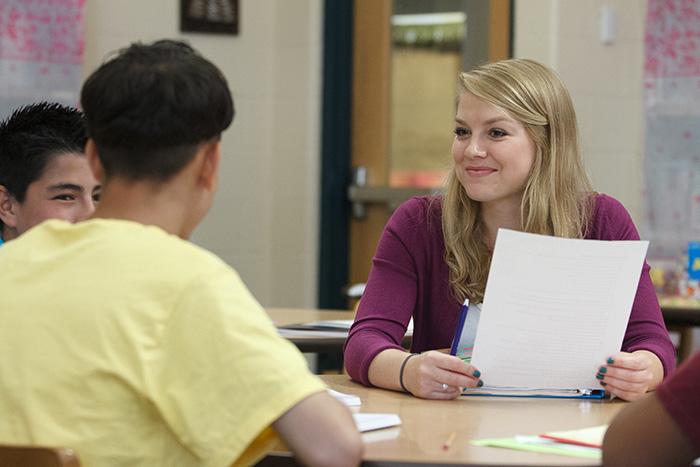Meta-classroom

Erin Malloy '15 works with students during her summer project exploring cross-cultural ways of empowering migrant youth in Adams County. Photo by Carl Socolow '77.
Student-faculty research meshes teaching, fieldwork and theory
by Ben West '14
Teaching and research enjoy a symbiotic relationship. At Dickinson, one symbiont feeds the other, with research so often the subject of teaching, and with teaching increasingly the object of research. Enter English major Erin Malloy ’15 and Elizabeth C. Lewis, assistant professor of education, whose joint summer project explores cross-cultural ways of empowering migrant youth in nearby Adams County.
“We do a social justice project where they choose any issue in the world or in their community that they want to change,” says Malloy. “And we’re giving them the tools to show how they’re going to do that.”
The tools Lewis and Malloy provide fall under literacy instruction, but in a broader sense than putting pen to paper. Teacher and student employ multimodality theory in their summer writing workshop, an approach to literacy that emphasizes multiliteracies and the myriad ways in which we read our world. The method opens doors for these teenagers and young adults—most of them children of migrant farm workers of Mexican heritage—to articulate their worldviews using logos, collages and images, in addition to the written word.
The results of the pair’s research will culminate in conference presentations in November and spring 2015 about integrating this expanded sense of literacy into the classroom and students’ lives outside of school. The students’ work will be published online and in a print anthology.
The experience has encouraged Malloy, who is working toward a classroom of her own. “It’s really taken everything I’ve learned at Dickinson in the education department and applied it the summer before I do my student teaching,” she says. “The timing could not have been better.”
Two skills Malloy has tested for the fall: poise before high schoolers (a notoriously tough crowd), and facility with the material (Lewis often lets her take the reins). “I would feel comfortable teaching these kids anything,” she says. “And I have [Lewis] to thank for that.”
Lewis notes that Malloy was at the top of her list. “I didn’t have any other students in mind,” she says. “I got to know her through teaching her in class and being her advisor, and I knew from her qualities and from [her] experience that she would bring so much to this experience, this collaboration and the kids themselves.”
Malloy observes a synergy between Dickinson’s values and the tone of her work in Adams County. “Dickinson has such a focus on writing and on being a part of the community,” she says. “This melds the two things perfectly: teaching these kids that they’re all writers. Whether or not they are going to write a novel in their lifetime, they still write on a daily basis.”
Published July 17, 2014